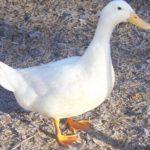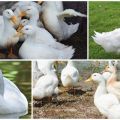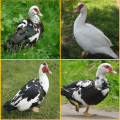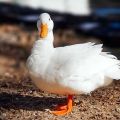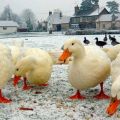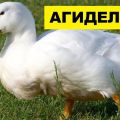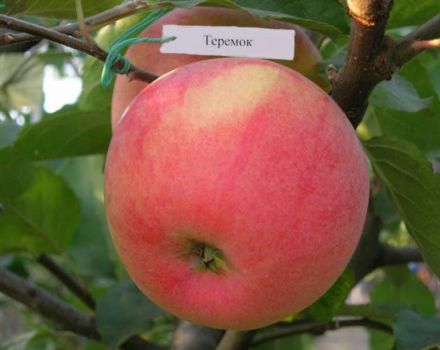Description and characteristics of ducks breed pace, breeding rules and diet
Among the breeds of domestic waterfowl bred for meat, the cross temp ducks stand out clearly. They are so useful and beneficial in the home garden and farming that they have seriously pushed other representatives of meat duck breeds. Excellent taste, early maturity and unpretentiousness made these birds one of the most common in farmsteads of modest and large-scale farms.
Description and characteristics of the breed
The progenitors of temp ducks are two breeds: the English cherry vellie and the Peking one. The result of crossbreeding was a new variation that immediately showed exceptional benefits. The new ducks were amazed by their egg production and the rapid increase in carcass weight. The resulting breed was called temp duck, or cross temp-1. Broiler ducks of the same name were also obtained. The breed was bred in Russia. The duck tempos are most widespread in the Russian Federation and Belarus.
The duck has an average size, strong constitution, the drakes are larger than females, the plumage is dense and white, smoothly fitting to the body. The legs and beak are orange. The head of the ducks is of medium size, with a long arched neck for this type of poultry. The tail is short, and the wings are large, with a swan span.
Tempo ducks begin to lay eggs at six months, while up to 90% are fertilized, so many chicks hatch, up to 70% of hatched or incubated eggs.
Pros and cons of ducks pace
Ducks of this breed are distinguished by the following positive characteristics:
- Early maturity - egg laying begins at 6 months.
- For a year, a temp duck can lay from 150 to 190 eggs.
- A drake weighs up to 3 kilograms, a female - up to 2.5 kilograms.
- Duck meat has a pleasant taste, no odor and low fat content, which favorably distinguishes the tempo and related cross tempo of the avant-garde from other breeds of meat poultry.
- The temp ducks are beneficial in that they can be used for two purposes: for obtaining eggs and meat, which brings additional benefits to the farmer or villager.
- The overwhelming majority of eggs in the clutch are fertilized, so many ducklings always hatch.
The disadvantages of the breed include the short breeding period for obtaining meat, since after 55-60 days the ducks begin to eat three times more food for each kilogram of weight gain.However, this feature is also a plus, because it allows you to get the maximum amount of quality duck meat in two months.
Maintenance and care
The pace of ducks does not cause much trouble for the owners. To do this, the following conditions must be met:
- Spacious poultry house. The ducks should not be cramped, otherwise they will not only fight, but also irritate each other and even peck eggs or pinch a feather on themselves.
- The room needs to be insulated when the ducks are kept year-round, for example, when breeding ducklings for sale or for eggs.
- The poultry house must be equipped with everything necessary. It should contain nests, clean bedding, food, drinking water in sufficient quantity and free access.
- Lighting is important not only for collecting eggs or for cleaning the room, but also for regulating the laying process.
- Ventilation is an important condition for the health of adult birds and offspring.
- The presence of a walk for ducks with access to the reservoir is encouraged.
- Cleanliness ensures the health of the adult herd and the safety of the offspring, as it prevents the spread of disease.

If the bird is raised as a broiler, it is important to provide adequate nutrition. To get dietary meat with a minimum amount of fat, it must be balanced, otherwise the duck will get fat.
What to feed?
The basis of feed for temp adult ducks is compound feed based on crushed grain. Ducklings need to be fed a wet mash, into which dairy products are introduced: at first - low-fat cottage cheese, reverse, whey, churning, and finely chopped greens.
The bird, which has access to walking, pecks up greens, small stones, invertebrates and insects on its own. Access to a natural or artificial body of water is also very beneficial. Ducks don't just swim and bathe, as water is their natural way of life. They are also very fond of duckweed and algae, which are rich in vitamins and other nutrients.
If ducks are deprived of the opportunity to swim in a river, lake or pond, as well as for feeding in winter, livestock owners harvest algae for future use or buy ready-made supplements from them.
Subtleties of reproduction
To obtain a large number of poultry for raising for meat, it is better to use incubation. This simplifies the process and allows you to achieve a large number of chicks at the same time.
Incubation lasts from 26 to 28 days, the yield of ducklings reaches 70%. Young growth is strong and viable, little susceptible to disease. Almost from the moment the ducklings hatch, the pace is fed with a steeply boiled chopped egg, from the fifth day of life, lean cottage cheese and finely chopped greens are introduced. Boiled root vegetables are added from a week, and from ten days of age, ducklings can add chopped waste from the kitchen and from the garden. Pounded egg shells are added to the feed.
Rapid growth and weight gain are provided by a quality, balanced diet. It is imperative to add minerals, milk waste and greens to the mash. Exercise is also important for the normal growth of ducklings, as well as for the duck breeding pace. Adult birds can walk all day in good weather, and ducklings can be released to graze at the age of 3 weeks.
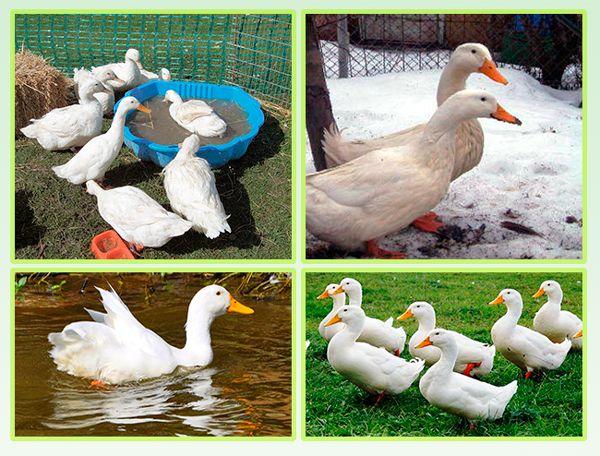
Prevention and treatment
Tempo ducks belong to unpretentious breeds, without a tendency to any specific diseases. They can suffer from diseases common to all ducks, but with proper maintenance and feeding, it is possible to avoid massive infections and death of birds.
For prevention, ducks are given:
- Drinking water tinted with manganese potassium in a pale pink tint.
- Fish fat.
- Bone meal.
- Crushed seashells.
- Limestone.
- Special mineral supplements.
Do not miss the opportunity to let the bird graze on the grass. It is useful for the body, strengthens the immune system, as it contains a large amount of vitamins.The same properties are possessed by algae, which waterfowl actively eat in water.
It is equally important to keep temp ducks clean. At the same time, it is necessary to thoroughly clean not only the poultry house, but also walking, as well as regularly wash and disinfect containers for water and feed, nests, and replace the litter. Then the bird will be healthy and strong, will not get sick and will actively reproduce.
